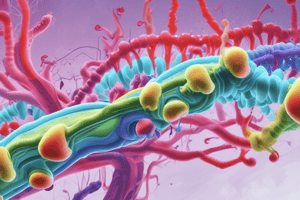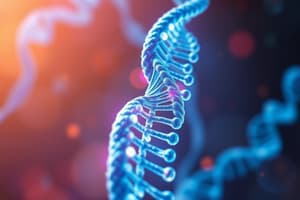Podcast
Questions and Answers
At what step in gene expression does a crucial point of regulation occur for most bacterial genes?
At what step in gene expression does a crucial point of regulation occur for most bacterial genes?
- Transcription initiation (correct)
- Translation of mRNAs by nonsense suppressors
- RNA splicing
- Nuclear export of mRNA
What phenotype would be observed in a bacterium with a null mutation in the gene encoding the Lac repressor?
What phenotype would be observed in a bacterium with a null mutation in the gene encoding the Lac repressor?
- Permanently repressed expression of the _lac_ operon
- Inducible expression of the _lac_ operon
- Unpredictable expression of the _lac_ operon
- Constitutive expression of the _lac_ operon (correct)
Why can transcription and translation be coupled in bacteria but not in eukaryotes?
Why can transcription and translation be coupled in bacteria but not in eukaryotes?
- Prokaryotes lack a nuclear membrane (correct)
- Bacterial DNA is organized into multiple chromosomes
- Eukaryotes lack a nuclear membrane
- Eukaryotic chromosomes are found in the nucleoid
How do negative regulators, such as the Lac repressor, prevent RNA polymerase from initiating transcription?
How do negative regulators, such as the Lac repressor, prevent RNA polymerase from initiating transcription?
How does a positive regulator typically enhance transcription by RNA polymerase in prokaryotes?
How does a positive regulator typically enhance transcription by RNA polymerase in prokaryotes?
What are proteins called whose conformation changes upon binding to an effector molecule?
What are proteins called whose conformation changes upon binding to an effector molecule?
Catabolic pathways, which break down complex substances, are typically regulated in response to what?
Catabolic pathways, which break down complex substances, are typically regulated in response to what?
Anabolic pathways are typically regulated in response to which of the following?
Anabolic pathways are typically regulated in response to which of the following?
Which statement accurately describes global gene regulation in bacteria?
Which statement accurately describes global gene regulation in bacteria?
What is the role of glucose in catabolite repression of the lac operon?
What is the role of glucose in catabolite repression of the lac operon?
What is the function of a helix-turn-helix motif in a transcription factor?
What is the function of a helix-turn-helix motif in a transcription factor?
How does tryptophan regulate the trp operon as its end product?
How does tryptophan regulate the trp operon as its end product?
What mechanism explains regulation of the trp operon in trpR– mutants, suggesting repressor-independent control?
What mechanism explains regulation of the trp operon in trpR– mutants, suggesting repressor-independent control?
What mediates the heat-shock response in E. coli, which alters protein production at different temperatures?
What mediates the heat-shock response in E. coli, which alters protein production at different temperatures?
As a general rule, what type of proteins do regulatory genes encode that interact with DNA elements in operons?
As a general rule, what type of proteins do regulatory genes encode that interact with DNA elements in operons?
Flashcards
Transcription Initiation
Transcription Initiation
A crucial step in bacterial gene regulation that occurs when RNA polymerase binds to the promoter region of a gene to start RNA synthesis.
Constitutive Expression of lac Operon
Constitutive Expression of lac Operon
The lac operon is always expressed, regardless of the presence or absence of lactose, due to the repressor protein being non-functional.
Coupled Transcription and Translation in Bacteria
Coupled Transcription and Translation in Bacteria
Transcription and translation occur simultaneously in bacteria because bacteria lack a nuclear membrane, allowing ribosomes to access mRNA as it is being transcribed.
Action of Negative Regulators
Action of Negative Regulators
Signup and view all the flashcards
Action of Positive Regulators
Action of Positive Regulators
Signup and view all the flashcards
Allosteric Proteins
Allosteric Proteins
Signup and view all the flashcards
Regulation of Catabolic Pathways
Regulation of Catabolic Pathways
Signup and view all the flashcards
Regulation of Anabolic Pathways
Regulation of Anabolic Pathways
Signup and view all the flashcards
Global Gene Regulation
Global Gene Regulation
Signup and view all the flashcards
Glucose's Role in Catabolite Repression
Glucose's Role in Catabolite Repression
Signup and view all the flashcards
Helix-turn-Helix Motif
Helix-turn-Helix Motif
Signup and view all the flashcards
Tryptophan's Regulation of the trp Operon
Tryptophan's Regulation of the trp Operon
Signup and view all the flashcards
E. coli Heat-Shock Response
E. coli Heat-Shock Response
Signup and view all the flashcards
Operon
Operon
Signup and view all the flashcards
Cis-Acting Elements
Cis-Acting Elements
Signup and view all the flashcards
Study Notes
Regulation of Bacterial Genes
- A crucial step in bacterial gene regulation occurs at transcription initiation.
Lac Operon
- A null mutation in the gene encoding Lac repressor results in constitutive expression of the lac operon.
Coupled Transcription and Translation
- Transcription and translation are coupled in bacteria, but not eukaryotes, because prokaryotes lack a nuclear membrane.
Negative Regulation and Transcription
- Negative regulators, like the Lac repressor, prevent RNA polymerase from initiating transcription by physically blocking the DNA binding site of RNA polymerase.
Positive Regulators and Transcription
- Positive regulators affect transcription by RNA polymerase in prokaryotes by interacting with RNA polymerase to increase the frequency of transcription initiation.
Allosteric Proteins
- Proteins that change conformation when bound to an effector molecule are called allosteric proteins.
Catabolic Pathway Regulation
- Catabolic pathways are regulated in response to the levels of the molecule that is to be broken down.
Anabolic Pathway Regulation
- Anabolic pathways are regulated in response to end product of the pathway.
Global Gene Regulation in Bacteria
- Alternative sigma factors are a mechanism of global gene regulation, recognizing different promoters.
Glucose and Catabolite Repression
- Glucose causes cAMP levels to decrease, which leads to decreased CRP binding, repressing the lac operon even when lactose is present.
Helix-Turn-Helix Motif
- A helix-turn-helix motif in a transcription factor binds a specific sequence in the major groove of DNA.
Tryptophan and the trp Operon
- Tryptophan, the end product of the trp operon, changes the conformation of the repressor, enabling it to bind DNA and block transcription.
Trp Operon Regulation
- Attenuation explains regulation of the trp operon in trpR– mutants suggesting the mechanism is repressor-independent
Heat-Shock Response in E. coli
- In E. coli, the heat-shock response is mediated by the synthesis of alternative sigma factors at high temperatures that activate transcription of heat-shock genes.
Gene Regulation and Operons
- Regulatory genes encode trans-acting proteins that interact with cis-acting DNA elements.
Trp Operon and Attenuation
- In the trp operon, mutating the two Trp codons in the leader sequence to stop codons leads to region 3 binding to region 4. This means transcription will proceed regardless of Trp presence.
Transcription Initiation
- Initiation of transcription by RNA polymerase involves the binding of the sigma subunit to the core enzyme.
Transcriptional Transition
- The transition from transcriptional initiation to elongation involves the release of the sigma factor.
Effector Molecules
- Allolactose and Trp are examples of effector molecules.
Operons
- A single DNA unit that enables the simultaneous regulation of more than one coding region in response to environmental changes is called an operon.
DNA Site Alterations
- Alterations to DNA sites, such as promoters and operators, can act only in cis.
Operon Theory
- Monod and Jacob proposed the operon theory.
Reporter Genes
- The lacZ coding sequence under the control of a prokaryotic promoter serves as an example of a reporter gene.
Sigma Factors and Heat-Shock
- Sigma 32 is the sigma factor that mediates a global heat-shock response in E. coli.
Tryptophan Regulation
- In the regulation of the trp operon, tryptophan acts as an effector.
Bacterial Strains
- The data for the fifteen bacterial strains suggests all strains have mutations that prevent transcription of the operon.
Transcription Factor Advantage
- It is advantageous for transcription factors to be multimeric and for their binding sites to be clustered because the strength of DNA-protein interactions is increased.
Small RNAs
- Small RNAs regulate gene expression by binding target RNAs and inhibiting translation.
Promoters for Antisense RNA
- Promoters for antisense RNA and target genes are oriented to transcribe opposite DNA strands of the same segment.
Lac Regulatory Region
- Using the lac regulatory region to control the expression of exogenous proteins in bacterial cells allows expression to be controlled by adding an inducer to the media.
Transcriptome Analysis
- Analysis of transcriptomes is useful for genetics research because it can reveal aspects of gene regulation.
E. coli and Bioluminescence
- E. coli aided by the cloning of bioluminescence genes from Vibrio fischeri, gene fragments from V. fischeri were cloned into plasmids, transformed into E. coli, and then retransformed back into V. fischeri.
V. fischeri Density Sensing
- V. fischeri senses the density of V. fischeri cells by secretion of a molecule that can be internalized and bound to a receptor in the cytoplasm.
Targeting Quorum Sensing Mechanisms
- Targeting quorum-sensing mechanisms for antibiotic development may have no selective advantage to individual cells that are resistant to quorum-sensing inhibitors.
Ribosome Binding Mutation
- A mutation in a ribosome binding site in the lac operon would likely result in reduction in the amount of LacZ, LacY, or LacA protein.
Bacterial Genotype
- Cells of genotype I+ oc Z + Y − / F' (I+ o+ ZR Y+) would be able to utilize lactose as an energy source.
Protein-DNA Interactions
- Some bands on the gel are absent in the sample with the transcriptional regulator, therefore the protein binds the DNA fragment.
Enzyme Function
- An enzyme functions in a biosynthetic pathway in bacteria. The product of the reaction regulates levels of the protein by binding an aptamer in the RNA leader sequence that alters the conformation to block the ribosome binding site.
Prokaryotic Genome
- If you identified five mRNAs that are not translated in these mutant bacteria, the five mRNAs are transcribed from five different genes located far from the deletion. This indicated the deletion prevents expression of a small RNA that regulates translation of all five genes.
Computer Analysis
- When RNA-Seq is performed before and after heat shock of bacterial cells, computer analysis would be expected to show after heat shock, an increase in the number of sequence reads of cDNAs that encode molecular chaperone proteins.
Studying That Suits You
Use AI to generate personalized quizzes and flashcards to suit your learning preferences.




